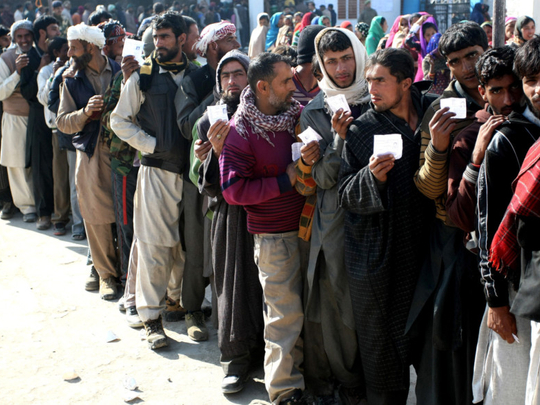
If politics is the art of making the impossible possible, the hung Jammu & Kashmir house presents the Bharatiya Janata Party with a golden opportunity to mend its sectarian character and, equally importantly, gives Narendra Modi a chance to blossom into a South Asian statesman by curbing his pro-Hindu instincts in the national interest.
I noticed pleasing signs of change in Modi during the November 26-27 South Asian Association for Regional Cooperation (Saarc) summit in Kathmandu. On November 26, Modi avoided even eye contact with Nawaz Sharif, Prime Minister of Pakistan although they spoke from the same dais, as it was the anniversary of the Mumbai attacks which India blames on Pakistan-backed militants; he behaved exactly as any Indian premier would have. But on November 27, Modi pumped Sharif’s hand privately and before TV cameras smiling from ear to ear.
The remarkable thing about the Modi-Sharif handshake was that it was preceded by an audacious attack on Indian army bunkers that very day in Arnia sector of Jammu & Kashmir on the India-Pakistan border which left eight 12 dead — three Indian soldiers, five Indian civilians and four militants. But Modi didn’t sulk or fly into a rage; there was no finger-wagging. He shook hands with Sharif despite the meticulously-planned strike which was so deadly that battle tanks had to be used to blast bunkers where attackers were holed up after killing Indian armymen.
Now let’s see whether Modi will bite the bullet and make the best of the fractured mandate in what former US president Bill Clinton famously described as the most dangerous place on earth. The moot point is — will Modi and the BJP rise to the occasion in Kashmir for India’s sake or make a hash of it?
To be sure, “Mission 44” — BJP’s shady operation to win 44 of Kashmir’s 87 legislative assembly seats to capture power through Hindu consolidation and appoint a Hindu Chief Minister in India’s only Muslim-majority state — fell flat on its face. The BJP failed to win a single seat in the Kashmir Valley — the bone of contention between nuclear neighbours — despite Modi’s entreaties at multiple rallies to repose faith in him. Intriguingly, it drew a blank also in Buddhist-cum-Shiite Ladakh region where it performed well in the May parliamentary elections. But to the BJP’s credit it bagged all the 25 seats in the predominantly Hindu Jammu belt making it the second largest party after People’s Democratic Party (PDP) with 28 in its kitty. National Conference (NC) and Congress have 15 and 12 seats respectively, and there are seven independents. BJP miserably failed to grab 44 seats but by increasing its tally from just 11 in 2008 to 25 and winning 23 per cent of votes — a larger share than any other party’s — compared to PDP’s 22.7 and NC’s and Congress’ 20.8 and 18 per cent respectively, it’s now a major stakeholder and a big player in the troubled state.
Shortlived triumphalism
A few centuries ago, a Mughal emperor overwhelmed by Kashmir’s beauty called it “paradise on earth”. But post-partition trauma ruined its heavenly ambience. In the run-up to the polls, the BJP lied that it wanted to revive Kashmir when it was merely trying to usurp it. The high voter-turnout in the five-phase polls led the media to conclude that even separatists had succumbed to Modi’s charm! But the triumphalism was shortlived; on counting day it became clear that while BJP’s scheme to split Jammu & Kashmir on religious lines paid dividends in Hindu Jammu, Muslim Kashmir voted determinedly to keep the BJP at bay.
The funny thing is that despite outright rejection by Kashmir’s core, BJP might still rule over the state just as it’s ruling over India with just 31 per cent of votes. There is a distinct possibility of a Hindu becoming the chief minister of Kashmir for the first time. Nothing prevents the BJP from buying a few independents to better the PDP’s tally and staking its claim to be invited first to form the government. The NC, which has a history of supping with BJP, might collaborate again to keep its regional rival, PDP, out of power. There is also a possibility of a PDP-BJP government although they are diametrically opposed. Or PDP, NC and Congress might unite to stop the BJP.
Obviously, all is fair in love and electoral war. While umpteen possibilities are bound to unfold as parties have a go at government formation, the time has come for the BJP to rise above its Hindu chauvinist agenda to bring about a long-awaited change in the lives of ordinary people in a ravaged frontier state which has borne the brunt of three full-fledged wars and the Kargil misadventure. BJP must alter its political and ideological goals in the interests of public welfare. If the BJP really loves India, it must now attach more importance to people than politics.
The BJP might lead the new government or the opposition or find itself somewhere in between. But irrespective of its position in the power structure, it must stop opposing Article 370 which guarantees Kashmir’s special status and instead fight for human rights, demilitarisation and economic integration of the two Kashmirs which will invariably bring India and Pakistan closer. It must stick to former premier Atal Bihari Vajpayee’s three-pronged formula: Insaniyat (Humanism), Jamhooriyat (Democracy) and Kashmiriyat (Kashmir’s legacy of pluralism) at any cost.
S.N.M. Abdi is a noted Indian journalist and commentator.










